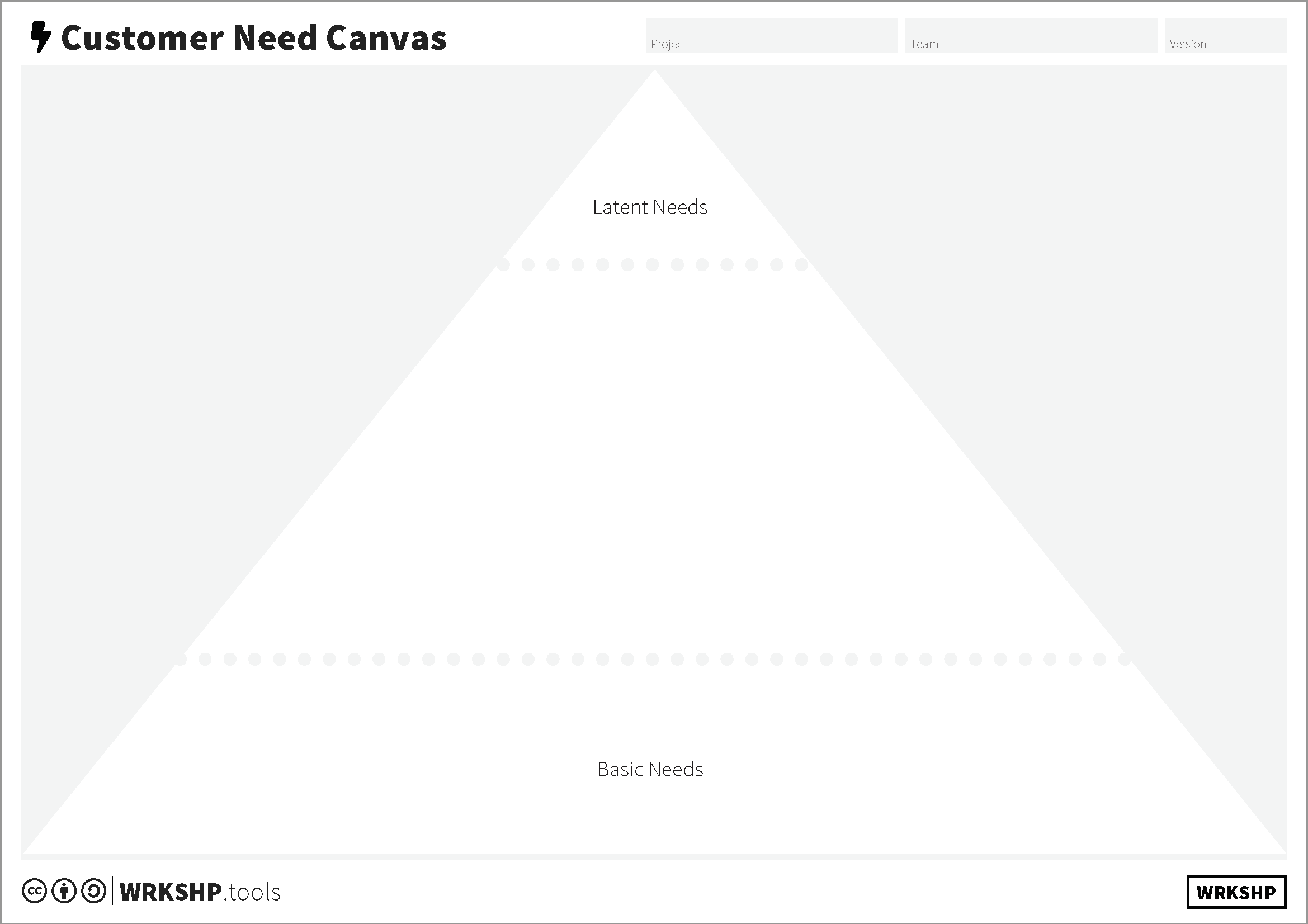Customer Need Canvas
The Customer Need Canvas helps you to make sense of the different needs you have uncovered for your potential customers.
Use this tool when:
- you want to select the most interesting problem to solve
Overview
| Time | ± 45 minutes | |
| Difficulty | 2 / 5 | |
| People | 3 - 5 | |
| Author | erik van der pluijm | |
| Website | ||
| License | CC BY SA 4.0 |

What is it and when should I use it?
The Customer Need Canvas helps you to make sense of the different needs you have uncovered for your potential customers, and separate the ‘latent needs’ (nice to haves) from the ‘core needs’ (must haves).
When coming up with problems (you think) people face, there are a number of aspects to keep in mind.
- Market Size - How many people face this problem?
- Customer Segments - What do people that face the problem have in common? How can you group them together and characterize them? And where are they best reached?
- Real Need vs Latent Need - Is the problem a real need for the potential customers? Or is is a nice to have?
Think of the Maslow pyramid. At the wide base of the pyramid, you find things everyone needs, such as food, water, rest. These are things you can't do without. At the narrow top, you find things that only become important to people once their basic needs have been fulfilled.
If you think of problems to solve for your business, think about where that problem is in the pyramid. Is it on the bottom, or at the top? This is a way to visualize latent needs vs real needs.
The problem with latent needs is that people don't really know or care about fulfilling them yet. They are 'optional problems'.
That does not mean that a latent need can't be huge: in a 1999 interview, people in Amsterdam laughed at having a mobile phone in their pocket every hour of the day. They simply could not imagine what it would be like yet.
Example Interview by Frans Bromet about the use of mobile phones in 1999 on the streets of Amsterdam. (English subtitles)
Convincing people of a solution to a latent need is an uphill battle. It can be done, but it is a lot harder than fixing something people are aware of as a problem.
The easiest way to tell if people have a real problem is to look for problems that people actually have a workaround for. Some way that they already solve that problem today. If that workaround is unsatisfactory for them, for instance it is expensive, takes time, or only solves part of their problem, then you have a candidate for a real need.
Tool Overview

Latent Needs These are ‘optional problems’. People either don’t feel that need acutely yet, or they are preoccupied with more basic needs.
Other Needs Other needs end up in limbo between latent and basic needs.
Basic Needs These are the problems people must solve. They have to deal with them on an everyday basis
Steps
1 Gather Needs
Using the Persona Canvas, Customer Journey, and qualitative interviews, come up with the needs and ‘jobs to be done’ your customers face. Or, coming from the other side, if you already have a preference for a solution, come up with the needs your solution helps fulfill. Have team members write each need on a separate post it note.
Tip! For different customer segments, use different color postits.
2 Map your Needs
Have all team members stick their post-its with needs on the canvas, one by one. Have a very short explanation with each. Put it where you think it should go for now.
3 Silent Shuffle
With all team members together, start reorganizing the needs. For each need: if you think there are more basic needs that the customer would need to have solved first, move it up towards latent. If you think that the need you’re shuffling is more basic, move it down. Do this for two or three minutes in silence
Tip! If a need moves up or down three times, put it to the side. We’ll address it next.
4 Discuss
Go over the map you have made. Each team member gets the time to address the points he or she does not yet feel comfortable with.
Tip! It’s okay if you have some needs that you don’t agree on. This is a first pass, and mostly reflects your own assumptions and biases - the fact that you don’t fully agree just means you need to do further qualitative experiments with your customers to find out!
5 Next Steps: Validate
Next, validate your map with customers. Focus your attention on the more basic needs first. Only when customers indicate these are solved do the more latent needs become important. And listen very carefully, perhaps your customers will tell you that there are other things they struggle with that are more fundamental.